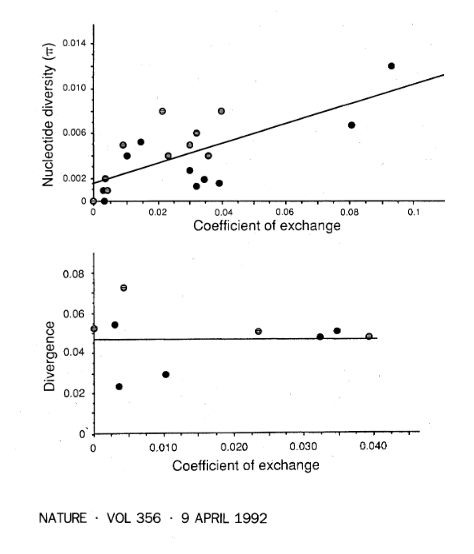Difference between revisions of "Begun and Aquadro 1992"
(→Notes) |
|||
| Line 10: | Line 10: | ||
=Notes= | =Notes= | ||
| + | The essential result is summarized in these two figures. | ||
[[File:BegunAndAquadro1992Figures.png]] | [[File:BegunAndAquadro1992Figures.png]] | ||
| + | |||
| + | Under the neutral theory diversity within a species is expected to be 4Nμ and divergence between species is expected to be 2tμ. Both of these are proportional to the mutation rate μ. Under a simple model 4N (N is the population size) and 2t (t is the time of divergence in generations) are not expected to change among loci. he mutation rate, μ, can easily change among different genes but the effect on both diversity and divergence is expected to be proportional. The authors found that diversity within a species increases with rates of recombination along a chromosome, but divergence between species did not. This is not consistent with the neutral theory and indicates some form of selection is shaping levels of genetic variation within species. | ||
[[Category:Publication]] | [[Category:Publication]] | ||
Revision as of 23:30, 20 October 2018
Contents
Citation
Begun, D. J., & Aquadro, C. F. (1992). Levels of naturally occurring DNA polymorphism correlate with recombination rates in D. melanogaster. Nature, 356(6369), 519.
Links
- https://www.nature.com/articles/356519a0
- http://hawaiireedlab.com/pdf/b/begunandaquadro1992.pdf (internal lab link only)
Published Abstract
TWO genomic regions with unusally low recombination rates in Drosophila melanogaster have normal levels of divergence but greatly reduced nucleotide diversity1,2, apparently resulting from the fixation of advantageous mutations and the associated hitchhiking effect3,4. Here we show that for 20 gene regions from across the genome, the amount of nucleotide diversity in natural populations of D. melanogaster is positively correlated with the regional rate of recombination. This cannot be explained by variation in mutation rates and/or functional constraint, because we observe no correlation between recombination rates and DNA sequence divergence between D. melanogaster and its sibling species, D. simulans. We suggest that the correlation may result from genetic hitch-hiking associated with the fixation of advantageous mutants. Hitch-hiking thus seems to occur over a large fraction of the Drosophila genome and may constitute a major constraint on levels of genetic variation in nature.
Notes
The essential result is summarized in these two figures.
Under the neutral theory diversity within a species is expected to be 4Nμ and divergence between species is expected to be 2tμ. Both of these are proportional to the mutation rate μ. Under a simple model 4N (N is the population size) and 2t (t is the time of divergence in generations) are not expected to change among loci. he mutation rate, μ, can easily change among different genes but the effect on both diversity and divergence is expected to be proportional. The authors found that diversity within a species increases with rates of recombination along a chromosome, but divergence between species did not. This is not consistent with the neutral theory and indicates some form of selection is shaping levels of genetic variation within species.
